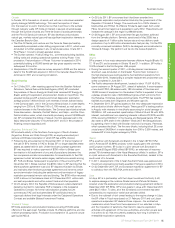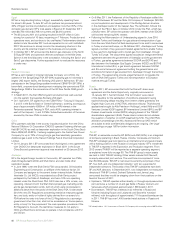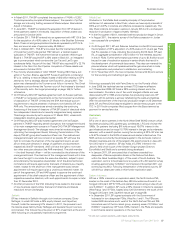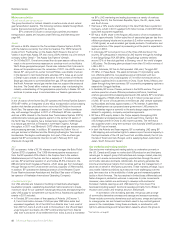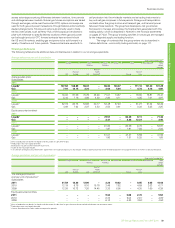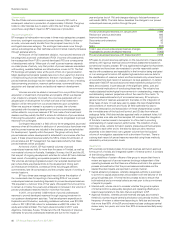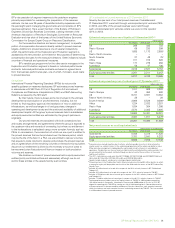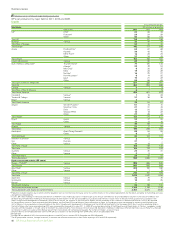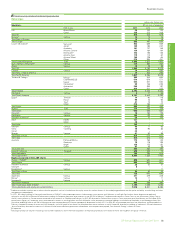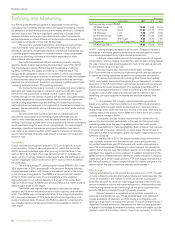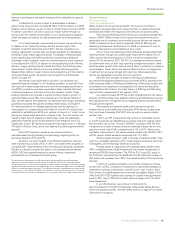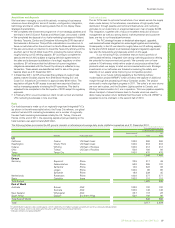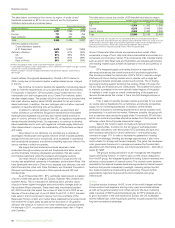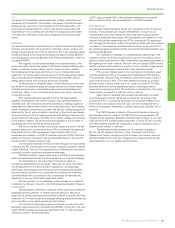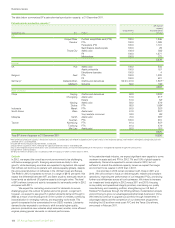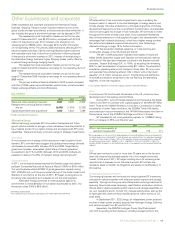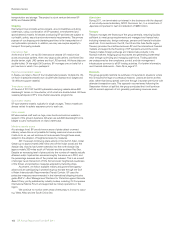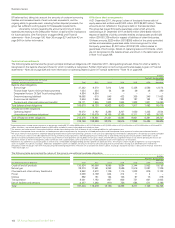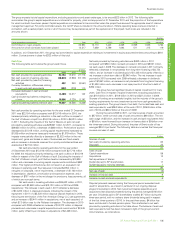BP 2011 Annual Report Download - page 97
Download and view the complete annual report
Please find page 97 of the 2011 BP annual report below. You can navigate through the pages in the report by either clicking on the pages listed below, or by using the keyword search tool below to find specific information within the annual report.
BP Annual Report and Form 20-F 2011 95
Business review: BP in more depth
Business review
balance of participation and capital employed from established to growth
regions.
In March 2010, we set a target to shareholders to deliver a
performance improvement of at least $2 billion by 2012 relative to a 2009
baseline and we believe we are on track to deliver this by the end of 2012a.
In addition, post-2012, we plan to grow our margin further through our
focus on growth markets and expansion of our margin capture capability,
which we expect to achieve through projects such as those described
below.
In our fuels business, as previously announced, we are planning
to dispose of our Texas City refinery and the southern part of the
US West Coast FVC before the end of 2012. We are investing in our
existing operations to sustain safe, compliant standards and selectively
investing in cash margin capture projects. The largest of these projects
is the repositioning of the Whiting refinery towards heavy feedstock
advantage, which is already under way and scheduled to come onstream
in the second half of 2013. In addition to the repositioning of the Whiting
refinery, margin capture projects include the Cherry Point refinery clean
diesel project, Toledo refinery continuous catalytic reforming project,
Gelsenkirchen refinery margin improvement programme and the recently
announced Brazil aviation acquisition (see Acquisitions and disposals
section on page 97).
We are also well positioned for growth in our lubricants and
petrochemicals businesses. In our lubricants business, around half of our
profit growth in recent years has come from the emerging economies in
non-OECD countries as we have expanded in these markets. We have
a material presence in the Indian automotive lubricant market. These
positions provide a strong base to capture further long-term growth. In
petrochemicals around 45% of our capacity is in the demand centre of
Asia. Growth options are enabled by our distinctive technology, operational
capability and access through key strategic relationships. During 2011
the latest example of our strategy deployment was the signing of a
memorandum of understanding with IndianOil Corp (IOC) to explore the
potential for establishing a 50:50 joint venture to invest in a 1 million tonne
per annum (mtpa) acetic acid plant in Gujarat, India. The joint venture will
use BP’s latest Cativa® catalyst and technology, while the associated
gasification facilities would utilize petroleum coke feedstock from IOC.
Additionally, in 2011 BP received local government approval for a 1.25mtpa
PTA plant in Zhuhai, China, and is now seeking final central governmental
approval.
From 2012 we plan to create a new revenue stream in
petrochemicals through licencing our technology, beginning with our
aromatics products of PX and PTA.
As part of our drive towards more efficient operations, we have
been transforming our back office. In 2011, we made further progress on
our global SAP implementation within the fuels and lubricants businesses.
We also continued to expand the scale of our business service centres
(BSCs). BSCs are regional centres for certain finance, operational
procurement and IT services for the BP group.
a This performance improvement will be measured by comparing Refining and Marketing’s
replacement cost profit before interest and tax for 2009 with that of 2012, after adjusting for
non-operating items, fair value accounting effects and the impact of changes in the refining margin
and petrochemicals environment (including energy costs), foreign exchange impacts and price-lag
effects for crude and product purchases. This adjusted measure of replacement cost profit before
interest and tax is non-GAAP. We believe the measure is useful to investors because it is one that
is viewed and closely tracked by management as an important indicator of segment performance.
Our performance
2011 performance
Safety and operational risk
Safety remains the top priority across BP, and we are committed to
leadership in process safety and to ensuring that our operations are safe,
compliant and reliable with regard to both personal and process safety.
Refining and Marketing utilizes the group’s operating management
system (OMS). OMS provides a set of group-wide requirements and a
systematic way of working to continuously improve the way we operate.
(OMS is explained in more detail on page 65). While all Refining and
Marketing entities have transitioned on to OMS, we continue to work to
enhance local systems and processes at all our sites.
All our major manufacturing entities (refineries and petrochemicals
sites) have been through two performance improvement cycles (PIC) of
OMS, and all other entities across our FVCs will have completed their
second PIC by the end of 2012. The PIC is a management review carried
out within each entity of their local operating management system, which
identifies areas where further actions can be taken to enhance our systems
and processes. These actions are risk-prioritized and form an integral part
of each entity’s annual and longer-term planning. Where appropriate,
actions are aggregated to provide common solutions.
Direction and oversight of safety in Refining and Marketing is
provided by the segment operating risk committee (SORC) chaired by the
chief executive officer of Refining and Marketing. Monitoring of safety and
compliance in our operations is conducted by the newly-formed safety
and operational risk function, for which there is a Refining and Marketing
segment team independent of the segment CEO.
As outlined on page 65, BP has further strengthened its risk review
process, and this process was applied to Refining and Marketing to ensure
that appropriate risk management and mitigating actions were prioritized
throughout the segment.
We measure our personal safety performance through the
employment of a recordable injury frequency (RIF) rate and a days away
from work case frequency (DAFWCF) rate, as well as a severe vehicle
accident rate.
In 2011, our RIF (measured by the number of recordable injuries
to the BP workforce per 200,000 hours worked) was 0.37, slightly higher
than the 2010 rate of 0.35. The 2011 DAFWCF (a subset of the RIF that
measures the number of cases where an employee misses one or more
days from work) was 0.108, compared with 0.114 in 2010. There was a
significant improvement in the severe vehicle accident rate (SVAR) in 2011
with 61 severe vehicle accidents compared with 77 in 2010.
While progress has been made in the area of personal safety, there
were two workplace fatalities in 2011. These tragic events have been fully
investigated, and the learnings shared and actioned.
Process safety is measured by the process safety incident index
(PSII), a weighted index which reflects both the number and severity of
events per 200,000 hours worked. The PSII for 2011 was 0.36, equal to
the 2010 rate, and better than the 2009 rate of 0.48. While the number of
PSII events has increased from 2010, the overall severity of the events has
reduced.
In terms of operational integrity, the number of losses of primary
containment (LOPC), a measure of unplanned or uncontrolled releases of
material from primary containment, was 5% lower in 2011 than in 2010.
The number of oil spills greater than one barrel was slightly higher in 2011
(145) than 2010 (132) however the volumes of oil spills were significantly
lower in 2011 than in 2010 at 0.4 million litres compared with 1.3 million
litres respectively.
In our US refineries, we continue to implement the
recommendations of the BP US Refineries Independent Safety Review
Panel and regulatory bodies. See the Safety section on page 67 for further
information on progress.


